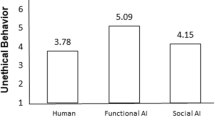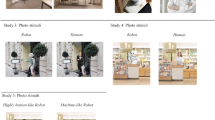Abstract
In order to build social robots that can coexist with human beings, it is necessary to understand the mechanisms of how communication protocols are developed in human–robot interactions. Our main goal is to explore how a communication protocol can be established incrementally between a human and our minimally designed robot which is called sociable dining table (SDT). SDT integrates a dish robot put on the table and behaves according to the knocks that a human emits. To achieve our goal, we conducted two experiments: a human–human experiment (Wizard-of-Oz) and a human–robot interaction (HRI) experiment. The aim of the first experiment was to explore how people build a protocol of communication. Based on the first experiment, we suggested an actor-critic architecture that simulated in an open-ended way the adaptive behavior which we determine in the first experiment. After that, we demonstrated in the HRI experiment how our actor-critic architecture enabled the adaptation to individual preferences in order to obtain a personalized protocol of communication.
















Similar content being viewed by others
Notes
We estimated this period based on a previous pilot study.
Continuous-knocking was related to the presence of contiguous disagreements about the shared rules, and we defined a disagreement state in the Sect. 4.3.2.
As an example, the percentage of agreement states \(=\) number of agreement states/(number of agreement states \(+\) number of disagreement states).
It consists of choosing the most frequent behavior that was previously associated to the same number of knocks previously received and led to an agreement state; e.g.,: choosing the left behavior when we have 3 knocks led most probably to an agreement state while choosing back may have led to a disagreement because it has led less frequently used for an agreement state based on the previous interactions.
Real time: Because the communication patterns emerge in a sequential fashion and we remarked that communication protocols were personalized to the pairs, any attempt to integrate a batch learning method to the robot’s architecture could not succeed in establishing the same customized protocols that we had seen in the first experiment, and that it is why we needed an online machine learning method. An online machine learning method gathers the data and learns incrementally.
We suppose that a knocking pattern that involves a number of knocks superior than 4 knocks.
We calculated approximately the value based on a pilot study.
Here we had actually 3 dimensions for each of the trials F1, F2 and F3 to reach 100 %, but the highest possible representation in 2 dimensions consisted of choosing the F1 and F2 more so than either F1 and F3 or F2 and F3.
The percentages were calculated based on the same formula used during the experiment 1.
References
Thomaz AL, Hoffman G, Breazeal C (2006) Experiments in socially guided machine learning: understanding how humans teach. In: ACM SIGCHI/SIGART conference on human–robot interaction, pp 359–360
Breazeal C, Hoffman G, Lockerd A (2004) Teaching and working with robots as a collaboration. In: Joint conference on autonomous agents and multiagent systems, pp 1030–1037
Michaud F, Duquette A, Nadeau I (2003) Realistic child robot Affetto for understanding the caregiver-child attachment relationship that guides the child development. Syst Man Cybern 3:2938–2943
Michaud F, Laplante JF, Larouche H, Duquette A, Caron S, Letourneau D, Masson P (2005) Autonomous spherical mobile robot for child-development studies. Trans Syst Man Cybern 35(4):471–480
Breazeal C, Scassellati B (2000) Infant-like social interactions between a robot and a human caregiver. Adapt Behav 8(1):49–74
Ishihara H, Yoshikawa Y, Asada M (2011) Realistic child robot Affetto for understanding the caregiver-child attachment relationship that guides the child development, Development and Learning (ICDL), pp 1–5
Levinson SE, Niehaus L, Majure L, Silver A, Wendt L (2012) Can a robot learn language as a child does?. In: AAAI spring symposium: designing intelligent robots
Ugur E, Nagai Y, Celikkanat H, Oztop E (2014) Parental scaffolding as a bootstrapping mechanism for learning grasp affordances and imitation skills. Robotica, pp 1–18
Squire KM, Levinson SE (2007) HMM-based concept learning for a mobile robot. Evol Comput 11(2):199–212
Xu Y, Ueda K, Komatsu T, Okadome T, Hattori T, Sumi Y, Nishida T (2009) WOZ experiments for understanding mutual adaptation. AI Soc 23(2):201–212
Xu Y, Ohmoto Y, Okada S, Ueda K, Komatsu T, Okadome T, Kamei K, Sumi Y, Nishida T (2012) Formation conditions of mutual adaptation in human-agent collaborative interaction. Appl Intell 36(2):208–228
Yamada S, Idea K (2003) interaction design for interaction. Jpn Soc Fuzzy Theory Intel Inform 15:185–189
Mohammad Y, Nishida T (2008) Human adaptation to a miniature robot: precursors of mutual adaptation. In: Robot and human interactive communication, pp 124–129
Mitsunaga N, Smith C, Kanda T, Ishiguro H, Hagita N (2008) Teachable robots: understanding human teaching behavior to build more effective robot learners. Artif Intell 172(6):716–737
Mitsunaga N, Smith C, Kanda T, Ishiguro H, Hagita N (2005) Robot behavior adaptation for human-robot interaction based on policy gradient reinforcement learning. Intell Robots Syst, pp 218–225
Castellano G, McOwan PW (2009) Analysis of affective cues in human-robot interaction: a multi-level approach. In: WIAMIS, pp 258–261
Zeng Z, Pantic M, Roisman GI, Huang TS (2009) A survey of affect recognition methods: audio, visual, and spontaneous expressions. Pattern Anal Mach Intell 31:39–58
Vinciarelli A, Pantic M, Bourlard H, Pentland A (2008) Social signal processing: state-of-the-art and future perspectives of an emerging domain. In: ACM international conference on multimedia, pp 1061–1070
Salvi G, Montesano L, Bernardino A, Santos J (2012) Language bootstrapping: learning word meanings from perception-action association transactions on systems. Man Cybern 42(3):660–671
Odahara Y, Ohshima N, De Silva PRS, Okada M (2013) Talking ally: toward persuasive communication in everyday life, human computer interace, pp 394–403
Shiomi M, Kanda T, Ishiguro H, Hagita N (2006) Interactive humanoid robots for a science museum, human-robot interaction, pp 305–312
Kanda T, Hirano T, Eaton D, Ishiguro H (2004) Interactive robots as social partners and peer tutors for children: a field trial. Hum-Comput Interact 19(1):61–84
Chao C, Cakmak M, Thomaz AL (2010) Transparent active learning for robots, human-Robot Interaction, pp 317–324
Subramanian K, Charles L, Andrea T (2011) Learning options through human interaction. Workshop on agents learning interactively from human teachers, pp 208–228
Matsumoto N, Fujii H, Goan M, Okada M (2005) Minimal design strategy for embodied communication agents. In: Robot and human interactive communication (RO-MAN), pp 335–340
Forlizzi J, DiSalvo C (2006) Service robots in the domestic environment: a study of the roomba vacuum in the home. In: ACM SIGCHI/SIGART human–robot interaction, pp 258–265
Kozima H, Yasuda Y, Nakagawa C (2007) Social interaction facilitated by a minimally-designed robot: findings from longitudinal therapeutic practices for autistic children. In: Robot and human interactive communication, pp 303–310
Okada M, Sakamoto S, Suzuki N (2004) Muu: artificial creatures as an embodied interface. In: Computer graphics and interactive techniques, pp 91–92
Youssef K, Yamagiwa K, De Silva PRS, Okada M (2014) ROBOMO: towards an accompanying mobile robot. In: International conference of social robotics, pp 196–205
Kina N, Tanaka D, Ohshima N, De Silva PRS, Okada M (2013) CULOT: sociable creature for child’s playground. In: Human-robot interaction, pp 407–408
Seiji Y, Tomohiro Y (2004) Training AIBO like a dog—preliminary results. In: Robot and human interactive communication, pp 431–436
Kiesler S (2005) Fostering common ground in human-robot interaction. In: Robot and human interactive communication, pp 729–734
Clark HH (1992) Areas of language use. University of Chicago Press, Chicago
Green A, Httenrauch H, Severinson EK (2004) Applying the wizard of Oz framework to cooperative service discovery and configuration. In: Proceedings of IEEE RO-MAN, pp 575–580
Shiomi M, Kanda T, Koizumi S, Ishiguro H, Hagita N (2007) Group attention control for communication robots with wizard of OZ approach. In: ACM Human-robot interaction, pp 121–128
Kahn PH, Freier NG, Kanda T, Ishiguro H, Ruckert JH, Severson RL, Kane SK (2008) Design patterns for sociality in human-robot interaction. In: ACM human robot interaction, pp 97–104
Shiomi M, Sakamoto D, Takayuki K, Ishi CT, Ishiguro H, Hagita N (2008) A semi-autonomous communication robot: a field trial at a train station. In: Joint conference on autonomous agents and multiagent systems, pp 303–310
Vijayakumar L, Sethu D, Schaal S (2005) Incremental online learning in high dimensions. Neural Comput 17(12):2602–2634
Sutton R, Barto AG (1998) Introduction to reinforcement learning. MIT Press, Cambridge
Grondman L, Busoniu L, Lopes GA, Babuska R (2012) A survey of actor-critic reinforcement learning: standard and natural policy gradients. Trans Syst Man Cybern 42(6):1291–1307
Acknowledgments
This research is supported by Grant-in-Aid for scientific research of KIBAN-B (26280102) from the Japan Society for the Promotion of science (JSPS).
Author information
Authors and Affiliations
Corresponding author
Rights and permissions
About this article
Cite this article
Youssef, K., Asano, T., De Silva, P.R.S. et al. Sociable Dining Table: Meaning Acquisition Exploration in Knock-Based Proto-Communication. Int J of Soc Robotics 8, 67–84 (2016). https://doi.org/10.1007/s12369-015-0314-y
Accepted:
Published:
Issue Date:
DOI: https://doi.org/10.1007/s12369-015-0314-y




